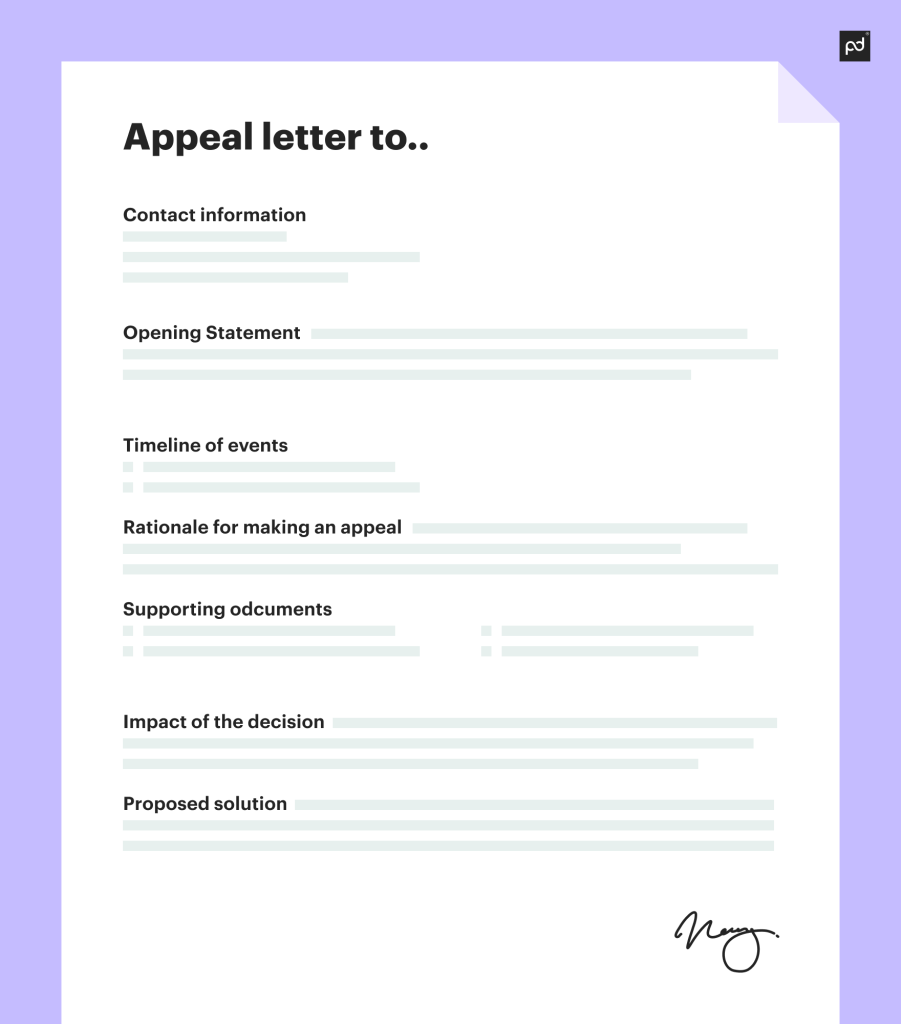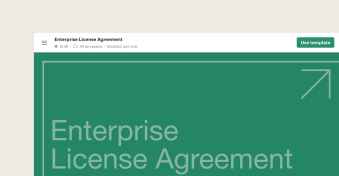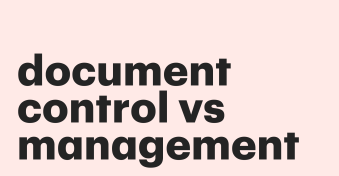When faced with an unfavorable decision, knowing how to write an appeal letter is a practical tool for urging the other party to change their mind.
Whether you feel that a decision was made unfairly, incorrectly, or in breach of contract, writing a letter of appeal is your chance to set the facts straight and present your case.
Decisions aren’t always set in stone — so it can be helpful to learn how to write an appeal letter and maximize your chances of reaching a mutually agreeable outcome.
Key takeaways
- Appeal letters are common in academic, business, and legal environments.
- As formal documents, they should follow a clear structure and professional tone.
- A good appeal includes a summary of the decision, a rationale for why you disagree, and a proposed solution.
- PandaDoc’s vast library of templates makes writing an appeal letter quick and easy.
What is an appeal letter
The right to appeal is often a core part of the decision-making process; the appeal letter is the official instrument for kickstarting a verdict review.
Appeal letters are usually reserved for professional settings when the stakes are high, and there’s a formal procedure for raising a complaint.
For example, it’s common to see them used by business leaders, legal professionals, or politicians — especially when they feel that a great injustice has been committed.
On the other hand, it would be bizarre if you wrote a letter of appeal to a fast-food employee who refused your request for extra pickles in a burger!
Business level
At the business level, the stakes are even more amplified.
A significant contract dispute with a supplier could suffocate your supply chain, or losing backing from a key stakeholder could threaten your financial outlook.
Small businesses and enterprises favor document generation software to create letters of appeal rapidly and for peace of mind that they won’t ever have to face a wrongful decision.
Letter of appeal format: important information to include
So, how do you write an appeal letter?
Your letter must be formatted correctly to ensure that it’s readable and its intent is understood.
If your reader is confused by your letter, it doesn’t bode well for your chances of reaching a settlement, let alone hearing back.

Regardless of the subject matter of your appeal letter, there are some key principles that you should follow during the writing process.
Firstly, your appeal letter must be comprehensive in its scope. Key information must be included so the letter makes sense when read alone.
Secondly, it must be persuasive in its tone. Everything you write must be action-oriented and build up to your proposed solution.
Ok, so how do you start an appeal letter?
Generally, there are three pieces of information that can signify to the reader what your letter is about:
- Document title: Your letter should state that it is an “Appeal letter to…” or an “Appeal letter for…”
- Contact information: Include the name and title of both yourself and the reader, as well as a return address, email address, or phone number.
- Opening statement: Sum up the purpose of your appeal by briefly summarizing the decision being contested and the grounds for your appeal.
From here, you can delve deeper into the details of your claim and why it is worthy of your reader’s attention:
- Timeline of events: Your description of the situation should be ordered chronologically so the reader can understand it from your perspective.
- Rationale for making an appeal: Outline any discrepancies in the decision-making process or points of contention that warrant a review.
- Supporting documents: Attach any legal or internal policy documents that could highlight the other party’s obligations when making a decision.
Now, how do you end an appeal letter?
Wrap it up with the following information:
- Impact of the decision: You should articulate how the decision has affected you (and others) personally and professionally without straying into overly emotional language.
- Proposed solution: End with a precise request for an action or reconsideration to be taken.
If your letter of appeal refers to a legally binding contract, adding a signature at the end is crucial.
Firstly, it informs the reader that you are who you purport to be.
Secondly, should the appeals process ever end in litigation, your signature proves that you expressly authorized the letter’s content.
You may also want to check whether the other party requires a signature on appeal documents, as is often true in academic or business environments.
Knowing how to write an appeal letter properly means having a structure with a clear beginning, middle, and end makes it easier for the reader to make sense of your argument and case.
Hopefully, this will bolster your chances of a decision being overturned or at least reconsidered.
How to write a letter of appeal in 8 simple steps
In this section, we’ll cover the steps for how to write a good appeal letter:
1. Understand the decision
Take a moment to digest the decision and whether making an appeal is worth your effort.
Is there another solution that would be easier and less time-consuming?
Never write an appeal letter when angry or upset; try to think rationally about the decision and approach it diplomatically.
2. Review the appeal process
Familiarize yourself with the formal procedure or guidelines for submitting an appeal to the recipient.
If there are none, use a standard template and follow the steps below.
3. Gather all the information you have
The next step is to collect and organize all pertinent information to the case.
Consider whether you have grounds for your appeal to be successful or if you need to spend time gathering evidence from other key figures.
4. Determine who will be reading your appeal
Identify the specific individual in the organization who will be reading your letter and address them by name and role if possible.
Directly addressing the reader has the psychological effect of establishing a personal connection and is likely to prompt a genuine and immediate response.
5. Explain what happened
Present your side of the story in a clear and factual manner.
You can make your account easier to follow by breaking up text with things like bullet point lists, subheadings, or a step-by-step chronology.
Avoid excessive wordiness — the recipient will likely remember making the decision in the first place.
6. Explain why you disagree
Tell them why you believe the decision was made unfairly or in error, and focus on objective evidence rather than your subjective opinion.
This is the time to dig your heels in and argue based on the facts.
7. Propose an alternative outcome
Finally, give the reader a ladder to climb down by suggesting a reasonable alternative to the decision.
You should explain why it would be in the reader’s interest to accept it, and you may want to use conciliatory language, such as calling it a ‘compromise’ or a ‘renegotiation.’
8. Sign your letter
As for how to end an appeal letter, simply attach your name, signature, and a polite concluding sentence.
A professional sign-off reinforces the respectful tone of your communication and provides a personal touch to your appeal.
Once you’ve sent your appeal letter, you’ll probably find yourself constantly refreshing your inbox or checking your mail as you await a response.
However, these decisions take time, and it’s important not to rush the process.
It’s courteous to wait at least one week before following up with a less formal phone call or email.
Appeal letter template: what should yours contain
If you have a PandaDoc account, look at our vast library of resources and effective document templates.
These can be a great starting point for learning how to write a letter for an appeal, shaving time off the appeal-writing process.
Alternatively, you can use this boilerplate template when making an appeal letter:
[Contact Information]
Your full name and title, address, email address, and phone number
[Date]
[Recipient Information]
The recipient’s full name and title/the position of the individual you’re writing to, the organization name and address.
[Document Title]
Appeal Letter to/for…
[Opening Section]
Dear [Recipient’s Name],
I hope this letter finds you well. I am writing to you today to formally appeal the decision regarding… [name or summary of the decision].
[Background]
Provide a concise explanation of the circumstances surrounding the decision.
[Rationale for Appeal]
Spend longer on this section. Highlight all of the reasons why you feel the decision was made unfairly, unjustly, or incorrectly.
Focus on objective points like ‘according to [a particular policy]’ rather than subjective statements like ‘I feel upset.’
Make reference to any supporting documents that you will include at the end of the letter.
[Proposed Resolution]
Offer an amicable resolution for both parties.
If you’re willing to renegotiate, suggest a timeline for when you could meet or talk with the other party.
[Impact Statement]
Explain the decision’s impact on yourself, your colleagues, and your business.
This is your chance to make an emotional appeal, as long as it’s professional.
[Closing Section]
Thank the reader for their time and consideration. End the letter with your name and signature.
[Supporting Documents]
Include external materials overleaf at the end of your letter.
Appeal letter example
High on our list of good documentation practices is having a document template ready for any circumstance or event.
So, let’s look at some hypothetical appeal letter examples; when you’d use them, and what you might want to include to make them as persuasive as possible.
Letter to an employer
Bad decisions have heavy consequences in the workplace — both for employees and employers.
For instance, imagine that you were suddenly fired from your job for an unclear reason.
Not only would you be left stressed and financially insecure, but your employer would have also lost a valuable employee.
This could have knock-on effects like a breakdown in team morale or even a wrongful dismissal lawsuit being lodged against the business.
Appeal letters, therefore, serve as a second chance for HR teams to rectify their mistake, as well as for employees to achieve a just outcome.
That said, you still need to explain the situation properly and express a constructive attitude toward resolving the dispute.
Try to include supporting documents that objectively back up your claim that the decision was made unfairly or incorrectly.
Feel free to use the following text as a template to get started:
Dear [Employer’s Name],
I am writing to formally appeal the decision regarding my recent dismissal from [Your Position] at [Company Name]. I believe that this decision was made hastily and without full consideration of the circumstances.
Nevertheless, I am keen to explore any misunderstandings or overlooked aspects of my performance that led to this outcome, and I am open to constructive dialogue about potential pathways forward…
Letter to a college professor
College professors have a big responsibility when it comes to marking work, as a poor grade could damage a student’s chances of landing a graduate position.
As such, colleges have strict policies for how the appeals process should be managed.
If you need to write an appeal, check on your college’s website if there are any specific guidelines to follow.
For instance, you may need to submit an appeal letter via your student portal, as this would allow both your professor and an independent college body to review your claim.
Template:
Dear Professor,
I hope this message finds you well. I am writing to you regarding the grade I received in [Course Name]. I have carefully reviewed the grading criteria and my submission, and I respectfully request a re-evaluation for the following reasons…
Letter to a project stakeholder
Unforeseen challenges are part-and-parcel of project management.
You might have a dispute with a project stakeholder over a change in project scope, involvement, or resource allocation.
In the worst case, a stakeholder could signal they’re pulling out of a project altogether.
Here, the appeal letter becomes a channel for seeking a renegotiation or compromise on key issues.
To personalize your message, you should discuss the project’s strategic significance to your working relationship.
Emphasize the shared goals and successes achieved when you work collaboratively together.
Highlight your commitment to a long-term working relationship and present actionable steps to repair the damage in the short term.
Template:
Dear [Stakeholder’s Name],
I am writing in light of the recent challenges we’ve encountered in the [Project Name]. I understand that the changes in scope and resource allocation have caused some unease, and I would like to propose a new platform for renegotiation.
Our shared successes lay a strong foundation for compromise, and I am firmly committed to working together to overcome these hurdles…
Letter to a healthcare insurance provider
Receiving notice of a denied insurance claim can be a challenging and stressful experience, particularly if your health and financial well-being are at stake.
Before panicking, take a deep breath and read your medical insurance policy.
If your operation or procedure is explicitly covered, then you know you’re entitled to claim for it.
If it isn’t mentioned, it may be time to talk with a doctor and get in writing their explanation for why it was necessary.
When writing your letter, craft a timeline of the facts surrounding the denied claim, including the date of service, the nature of the treatment, and the reasons cited for denial.
Finally, make sure to submit it via their official appeals channel.
Since healthcare is such a heavily regulated industry, insurance providers have a duty to respond to every appeal and provide reasons for why they arrived at a decision.
If you think they made a mistake, you should escalate the claim to your state health department or seek legal specialist counsel.
Template:
Dear [Insurance Provider’s Name],
I am contacting you regarding the denial of my recent claim for [Name of Medical Procedure/Service]. I have since reviewed my insurance documents and believe that this decision was made in error.
The treatment I received on [Date] at [Healthcare Facility’s Name] is, to my understanding, covered under my policy. Enclosed is a timeline of the events and relevant documentation for your review…
Make writing an appeal letter simple with our tips
To wrap up, knowing how to correctly write an appeal letter is a universal skill — essential for everyone from students and professionals to small business leaders and enterprise legal professionals.
Even if overturning a decision is off the cards, there’s usually room to compromise or negotiate a new working relationship.
Time is of the essence, as it’s often easier to deal with a wrongful decision immediately after it’s made rather than further down the line.
As such, it’s a good practice to have a boilerplate template ready in anticipation of these moments.
With PandaDoc, you can access our vast library of 1000+ business document templates that will jumpstart your document creation process and teach you how to construct a compelling narrative.
Our platform makes it easy to attach eSignatures, track document progress, and share resources with collaborators.
Whatever your needs, we have you covered.
Frequently asked questions
-
An example of an appeal letter is when an employee wants to negotiate a decision made by their employer.
For instance, an HR leader could have mistakenly sent a disciplinary letter or work schedule change based on an incorrect decision.
Or, perhaps, they unfairly demoted an individual. An appeal letter is a polite “check and balance” to counter these decisions.
-
Appeal letters are meant to be read in their entirety.
However, if you send an excessively verbose or lengthy letter, your reader may get bored before they read the necessary parts.
Try to condense your writings to one or two pages — ideally 500 words long — and follow a regular structure with clearly marked subheadings.
-
An appeal letter is a formal channel for requesting a decision be overturned. As such, your language and tone should reflect this — at no point straying into angry or accusatory language.
You should also avoid straying into discursive topics or making unsupported claims based on opinion rather than objective evidence. Keep things professional, and you’ll maximize your chances of hearing back.


